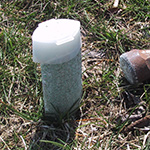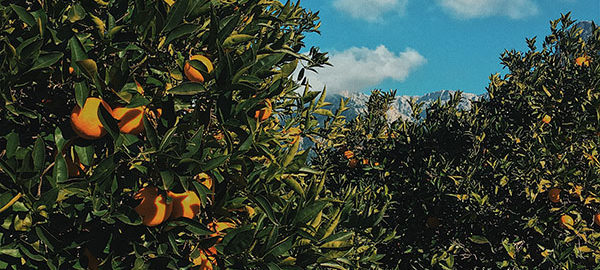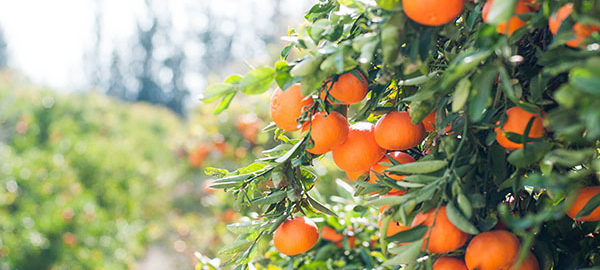
Citrus trees that yield oranges, grapefruit, lemons, and tangerines are one great way to make a property look beautiful; and they even provide shade and snacks for homeowners who have them! The most popular citrus grown worldwide are oranges, with grapefruit not far behind.

States in the US with the most citrus trees are California, Florida, Arizona, and Texas. Florida’s trees produce mostly juice. These states are actually the ONLY citrus-producing states in the entire nation!
So what does it take to grow your own citrus tree in your very own backyard? If you aren’t in one of the four states mentioned previously you can give it a try, but it’s easier in the southern states. It’s not unheard of to get one to survive in other climates and regions, however! Most arid climates can grow beautiful citrus trees, just watch out for frost and cold snaps!
Arizona History Lesson – Citrus
Citrus production in Arizona began during the 1860s when Jack Swilling reconstructed the Hohokam Canals in central Arizona. This, coupled with the construction of the Salt River irrigation systems, helped crops like cotton and oranges grow in the desert. It was mainly miners and cavalrymen living in Arizona at the time, and they and their families needed any crop they could get in a place where most plants don’t take well to the drier soil and little rainfall. The existence of nearby orange and other citrus fruit trees became a matter of life and death when workers in the mines of Arizona and California got scurvy. And that’s how Arizona’s citrus industry flourished.
Weather Conditions – Sorry North Pole!
Citrus trees are sensitive. They cry, they laugh, they love… Just kidding! Not that kind of sensitive. Rather, they will literally die if they catch just one night of frost! So wherever you grow your trees, please cover your citrus with a blanket or sheet if you think there is even the possibility of freezing temperatures or lower. Veterean desert dwellers even know this is a risk in their climate. Some growers have recommended putting up strings of lights around the tree to keep it warm. This strategy also improves ambiance and adds to backyard beauty.
Climates like Arizona’s that are hot and balmy or that remain temperate and steadily warm are ideal for growing citrus trees.
FACT: Of all citrus trees, lemons are the most sensitive to frost. Lemons are SUPER picky trees and do best in well-drained soil to keep diseases and fungus away from the roots.
When Should I Plant Citrus Trees?
Technically, citrus trees are able to be planted any time of the year, but experts recommend the months of March, April, and October.
Should I Plant an Orange, Lemon, or Grapefruit Seed?
As kids, we all thought we could grow a tree from whatever we placed in the ground — paper clip trees, gum trees, money trees, tooth trees, you name it. Sadly, this is not the case with citrus.
The recommendation to grow a citrus tree is not to start one from seed, but to begin with a small citrus tree from your local nursery or a friend’s yard. Small trees are able to establish roots much better, especially in dry soil. When visiting the nursery, mention that you would like to a buy 15-gallon container of the citrus tree of your choice. Believe it or not, this size is considered small!
Trees in the citrus family are prone to transplant shock, which can occur when they are moved to a larger soil environment as they grow. Shock happens during the uprooting process and is a result of the tree being unable to absorb water through its roots. In order to avoid transplant shock, be sure to keep the roots wet during transport. It is also very important to be gentle with the roots of the tree. More of the roots that are torn away or damaged increases the risk of shock. It is important that your new tree can successfully grow new roots. Follow these instructions and you should have a great crop and a happy, blossoming tree!
When Should I Water my Citrus Tree? Can I Over-Water it?
Great question! Water every one or two weeks in the summer and three to four weeks in the winter (if there even is one in Arizona!). There is certainly a time when citrus trees are in danger. The few months of cold that Arizona sees is literally the most important time to watch and care for your citrus trees, young or old. The winter months are when they can make it or break it.
Citrus trees are one of a few plants that succeed when watered a LOT. But don’t give them constant water; be sure to give them time to dry out before watering again. If you don’t, you risk root rot. Water more often if you have rocky or sandy soil, as these soil media lend themselves to better drainage. Water less often if you have rich, clay-like soil as this holds water longer for the roots to access it.
How do I Maintain My Citrus Tree?
White Paint?

Ever notice the white paint that looks like socks on the trunk of citrus trees as you drive from neighborhood to neighborhood around Arizona? Believe it or not, that is done for mainly decorative reasons! The paint can also helps prevent bugs from invading the tree via its trunk and it keeps the trunk cool when the sun hits it. It also helps deflect the sunlight away from the large branches and lower leaves, or they will literally get sunburned. Consider it a sun tan lotion, SPF citrus. Experts can’t really agree if the paint is effective or not, but Arizonans swear by it.
Pruning?

If you’ve ever hired someone to prune or have been tasked with the project, make sure you’re seated before you read this! It is literally completely unnecessary to prune a citrus tree. Further, they grow best when not pruned! However, if you want your citrus tree to look neatly trimmed and nicely shaped or to bear fruit in certain spots, keep pruning.
Just as with painting a citrus tree white to avoid the sun burning the trunk or large branches, this is also the idea behind not pruning. Don’t trim back what the sun will hit, or you may have a fatality on your hands.
Fertilizing

Fertilize your citrus trees three times per year. In the spring months of late February and early March are recommended. Be sure to read the instructions on the fertilizer packaging. Some experts suggest getting the kind specifically made for fruit and nut trees, while others highly say to assess your soil type and proceed from there. This would be good advice to get at the time you purchase your plant.
How Long Will My Tree Live?
Citrus trees have a lifespan of about 25 years. Some live longer and some not quite as long. Grapefruit trees have a tendency to outlive most other citrus trees and can become huge bush-like plants that produce fruits throught the year. And they require even less pruning than the other citrus plants.
Arizona Orange Company is proud to be a part of Arizona’s citrus history! With the very best quality tangerines, oranges, lemons, grapefruit, and specialty treats that you can ship to loved ones or as a gift for yourself, we are a must for anyone who loves fresh gourmet at their doorstep!












Can orange trees grow in Prescott Valley, AZ?
Do clementines do well with full sun if they will even grow here ?
Do I remove the fruit before first frost..? Or very very cold temperature in Arizona?